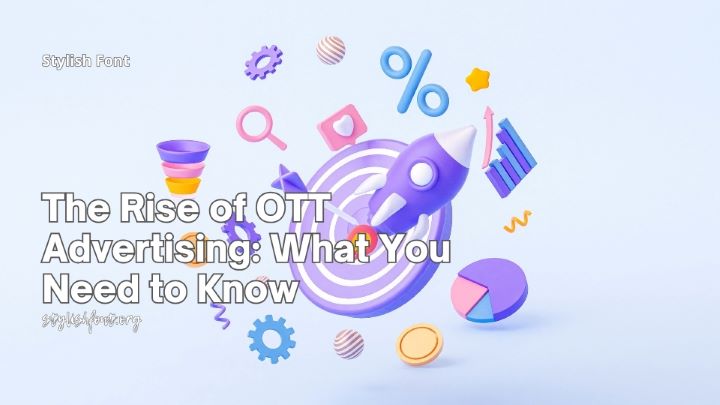Key Takeaways
- OTT advertising offers a highly targeted and measurable way to reach audiences.
- Understanding the advantages of OTT can elevate your marketing strategy.
- Technological advancements are continually enhancing the OTT advertising landscape.
Introduction to OTT
OTT advertising transforms marketing by delivering content directly to viewers via the Internet, bypassing traditional cable and satellite methods. This shift towards OTT services is due to consumers moving away from conventional cable, offering marketers a unique opportunity to target a more specific audience with customized advertising strategies. Unlike traditional broadcasting, which is limited by time slots and geographic constraints, OTT advertising utilizes the Internet for unmatched flexibility and precision. It allows for targeted advertising based on viewers’ habits, demographics, and behavior, ensuring the right message reaches the right person at the optimal time, thus maximizing advertising effectiveness.
Benefits of OTT Advertising
OTT advertising offers significant benefits, making it an attractive option for modern marketers. One of the most appealing is the precision with which specific demographics can be targeted. Traditional TV advertising casts a wide net to catch as many viewers as possible, often resulting in a less efficient ad spend. In contrast, OTT platforms allow advertisers to focus on particular segments, enhancing the efficiency of their marketing efforts.
Additionally, OTT advertising provides more measurable outcomes. Metrics such as views, clicks, and conversions can be tracked accurately, allowing brands to gain better insights into their audience and optimize future campaigns. This level of detail can inform all aspects of marketing strategy, from creative direction to budget allocation, making OTT advertising a powerful tool in a marketer’s arsenal.
Another critical benefit involves the diverse ad formats available through OTT services. These formats range from traditional video ads to more interactive and dynamic options. Interactive ads, in particular, allow for direct consumer engagement, which can significantly increase brand awareness and loyalty. By offering these varied formats, OTT advertising can cater to different marketing objectives and provide a richer experience for the audience.
How OTT Differs from Traditional TV Advertising
Unlike traditional TV advertising, which relies on scheduled broadcasts constrained by airtime and program slots, OTT ads are delivered on demand. This on-demand nature means ads can be timed flexibly and inserted dynamically, tailoring ad placements to viewer behavior and preferences.
Moreover, OTT platforms often offer interactive ads, encouraging user engagement beyond passive viewing. These interactive elements can capture viewer data and provide a richer ad experience, effectively merging the reach of television advertising with the interactivity and targeting capabilities of digital ads. This interactivity engages viewers more profoundly and provides brands with valuable data on audience preferences and behavior.
Another significant difference is the ability to skip ads. Traditional TV often forces viewers to sit through commercials, frustrating viewers. OTT advertisements, however, are usually skippable after a few seconds, leading to a more user-friendly experience. This skippable feature adds a layer of competition, pushing marketers to craft compelling content that captures attention immediately. Hence, creativity and relevance become even more critical in capturing the viewer’s interest.
Measuring Success in OTT Advertising
Measuring success in OTT advertising involves several critical metrics that provide a holistic view of ad performance. These include:
- Impressions are the number of times an ad is shown, giving marketers an idea of its reach.
- Click-Through Rate (CTR): The proportion of viewers who engaged with the advertisement, indicating the level of interest and involvement it sparked.
- Conversion Rate: The rate of viewers who took the desired action, such as purchasing a product or signing up for a newsletter, indicates the effectiveness of the ad in encouraging action.
- Watch Time: The amount of time viewers spend engaging with the ad, providing insights into how compelling and engaging the ad content is.
Utilizing these metrics helps refine future campaigns and boosts overall ROI. Advertisers can analyze which ads perform best in different contexts, leading to more informed decisions about where to allocate their advertising budget.
Technological Advancements in OTT
Technological advancements drive the ongoing evolution of the OTT advertising landscape, improving its capabilities. Programmatic advertising, such as real-time bidding, enhances the efficiency and targeting of ad purchases. This system enables the buying and placement of ads within milliseconds, using the viewer’s profile and behavior to ensure the most appropriate ads are delivered to the correct audience promptly.
Moreover, AI helps to forecast viewer preferences, improving the customization of advertisements. AI algorithms examine large quantities of data to forecast which material will connect most with viewers, enabling extremely personalized ad encounters. These advancements benefit advertisers and enhance user experience by delivering more relevant content. As technology advances, we expect to see even more innovative features and improvements in the OTT advertising space, further solidifying its position as a key player in modern marketing strategies.
Future of OTT Advertising
The future looks promising for OTT advertising since more and more consumers choose streaming services for their content consumption. The forecast is that the shift in viewing habits will continue, driven by increased high-speed internet availability and the expanding variety of smart gadgets. As a result, the audience for OTT services is predicted to keep growing, providing more opportunities for advertisers to reach their target viewers.
As consumers gain a greater understanding of their privacy rights, advertisers and platforms need to implement transparent and secure data practices. This may result in the creation of innovative technologies and guidelines that improve data security while enabling efficient and focused advertising. Overall, it is expected that over-the-top advertising will significantly impact the evolution of marketing. Having the capacity to provide precise, quantifiable, and captivating advertising encounters is a valuable resource for firms aiming to engage with their audience in impactful manners.





